- Submissions

Full Text
Open Access Biostatistics & Bioinformatics
Explaining Birds Colorful Plumages and Beauty Preferences by Demand Relationships with Information and Confidence Level Analyses
Chenguang Lu*
Liaoning Engineering and Technology University, China
*Corresponding author: Chenguang Lu,16678 77 Ave, Surrey, BC, V4N 0L3, Canada
Submission: December 11, 2017; Published: January 12, 2018

ISSN: 2578-0247Volume1 Issue1
Abstract
Why do many male birds display specific colorful patterns on their plumage? The demand-relationship theory explains that beauty preferences reflect human and birds' desire for approaching some objects; these patterns look beautiful because they resemble their ideal food sources or environments. Mutants that have enhanced human and birds' ability and motivation in finding these were hence selected by nature. Such beauty preferences of the female birds then selected the male plumage. Some convincing photos are provided. A statistical analysis about inference "If a bird has yellow feather then it probably likes eating nectar” shows that this inference has higher confidence level and conveys more semantic information than inference "If a person has high triglyceride then he probably also has fatty liver”.
Keywords: Beauty preferences; Sexual selection; Demand-relationship theory; Food resources; Colorful plumage; Hypothesis testing; Shannon's information; Semantic information; Confidence level
Introduction
We find certainly things beautiful and some ugly. There may be social, educational, and cultural factors affecting such preferences and there may also exist large interpersonal differences in such preferences. However, some common factors at the nature level cannot be denied. For example, most men find the naked bodies of women in their fertile ages attractive. This beauty preference makes them seek fertile women and mate with them. This helps them to pass on their genes. The natural selection of such fitness- enhancing preferences is obvious. However, there are some aspects that are not obvious or even have been controversial since the time of Darwin [1], as discussed below.
Darwin [1] explains that fragrance and colorfulness of flowers are to attract insects to pollinate for them; good flavor and colorfulness of fruits are to attract birds and mammals to swallow to spread their seeds. However, He was puzzled by why insects, birds and mammals have such tastes. He wrote (Chapter 6, Section 8): "How the sense of beauty in its simplest form that is, the reception of a peculiar kind of pleasure from certain colours, forms and sounds was first developed in the mind of man and of the lower animals, is a very obscure subject. The same sort of difficulty is presented if we enquire how it is that certain flavours and odours give pleasure, and others displeasure. Habit in all these cases appears to have come to a certain extent into play; but there must be some fundamental cause in the constitution of the nervous system in each species."
Darwin [1] advanced sexual selection to explain the colorful appearances of male birds in terms of female beauty preferences or aesthetic tastes [2]. Wallace [3,4] objected strongly saying that this is adding an additional principle of beauty selection on top of natural selection, without explaining how female taste for beauty comes from. Wallace used camouflage and signaling to explain colorful plumage in birds, used good sense or sign to explain female sexual selection (selecting good characteristics in males), while denying the selection of male appearance by the taste for beauty of the female birds. Later, Fisher [5,6] advanced a theory in sexual selection called arm-race theory to reconcile the contradiction between Darwin [2] and Wallace [3]. It is Fisher [5] who initiated the likelihood method for hypothesis testing.
Wallace [4] explains the plumage of female birds and dancing in many bird species better, while Fisher [6] explains the big tails in some bird species better. There are also other theories [5,7,8] with some advantages. However, more cases (eg. the ocelli in the plumage of Peacocks, the yellow tail of Mandarin Ducks, the special patterns in the faces of Baikal Teals, Macaws, and King Vultures) are difficult to be explained by current theories. According to biological utilitarianism, the various tastes (including beauty preferences) of animals (including man) should be beneficial to biological fitness (survival and reproduction) for them to survive after their emergence. Accordingly, we proposed a demand- relationship theory for the evolution of tastes [9-11]. According to this theory, pleasant sensations reflect demand relationships and promote their developments. Sense of beauty, as one of pleasant sensations, reflects and stirs our desire for approaching some objects or environments that may be directly or indirectly beneficial to our survival. This evolution may be through both nature (biological variation; mutation in particular) and through nurture (environment, education, learning, etc.).
The co-evolution of flowers and insects and that of fruits and birds and animals are the results of nature (through variation and selection). We may imagine [9] that originally flowers were not colorful, and insects did not have good tastes for flowers. Since cross-pollination is particularly beneficial, those plants that mutated to have pollen and nectar needed as food by insects gained an advantage and prospered more. Simultaneously, those insects that developed a taste (in sight, taste, or smell) for pollen and nectar had higher motivation for seeking flowers. This led to mutual reinforcement and a high degree of co-evolution, resulting in very fragrant and colorful flowers. Similarly, the emergence of fragrant and colorful fruits when ripe made them more easily found and eaten by birds and animals, helping them to spread their seeds. Birds and animals with such tastes have higher motivation and ability in locating these fruits, leading also to co-evolution.
We all find cow dung ugly. However, people in Tibet use it to decorate home1. This may be explained by the fact that these people have had a long history of seeking after cow dung, using it as fuel. This high demand might have fostered their taste for beauty in cow dung. The evolution of demand observes the rule of means turning into ends [10,11]. For example, fishing was the means for eating fish, but it has become an end in itself; kissing was the means for having sex, but has become an end in itself; if the fruits are nice food, their flowers also appear beautiful. This is so because it is easier to obtain the fruits in an environment with such flowers. This is the reason for man and animals finding flowers beautiful.
The author is not alone. After he proposed the above theory and found that peacock mimicked the berry tree [9], Jacobs ME [12] also proposed this finding. Rodd et al. [13] found that guppies had orange round spots on their tails for mimicking their favorite foods. This finding obtained very high praise by a paper on Science [14]. This study will provide more detailed evidence to support the demand-relationship theory of beauty preferences, including some photos and some statistical results.
Materials and Methods
Using food sources and environments to explain birds' colorful plumage
We wish to advance a food-source demand-relationship theory to explain the particular patterns, not only in the peacock but also in many other species. The basic idea is this. Members of a species A prefer to eat a certain food source X. This relationship allows A to evolve so that A's members (female members in particular) finding X beautiful. Once this beauty preference is established, if some male members of A happen to possess some aspect of X that attracts female members of A, perhaps by mutation, they will then attract more females of A to mate with them. This trait of male members of A that mimic X then got selected. That this process may work is clear. That it in fact did so in many species are presented below on the very close similarity of the colorful patterns of some parts of the male members being very similar to the main food sources of the relevant species.
Why does the plumage of Peacocks contain the distinctive ocelli in their tails? Peafowls like to eat berries. This first led to them to find berries beautiful. This beauty preference of peahens then selected for the ocelli in the tails of peacocks so that a peacock displays the tail that looks like a berry tree (Figure 1). Peacocks display and shake their tails while courting, probably mimicking the movement of a berried tree in wind. There is a parallel to this; The Peacock Pheasant also has similar plumage with ocelli looking more like balls (Chapter 13). Both Peafowls and Peacock Pheasants like to eat berries (Figure 12,3 ).
Figure 1: A Peacock (a) and a wild blueberry tree (b).
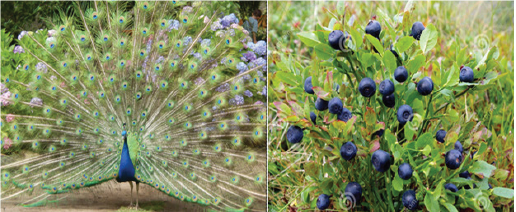
Figure 2: Beautiful fruit doves with heads that mimic the red fruits.

We can find, in Yunnan province, China, that the area where the peacock used to live [15,16] and the area where the wild blue berry grows are highly overlapped. These areas also abound with plums. It is very possible that the Peacock mimics the blueberry tree or the plum tree. We tested peafowls and pheasants with blueberries and corns. It was obvious the blue berries were more attractive to peafowls whereas corns were more attractive to pheasants4. Similarly, many birds such as Beautiful Fruit Dove have red spots on top of their heads that clearly mimic ripe fruits that those birds like to eat (Figure 25). The Carduelis has similar head because this bird also likes eating red fruits. Similarly, a parrot may have a mangolike head6. We can also find some birds, each of which seems to have a flower on head, such as Kinglet and Goldcrest. These birds must like flowers for eating nectar. Also, many birds display patterns of grain ears in their plumage because they like to eat these grains. Birds with grain-like plumage include Montezuma Quail7, Zebra Finch8 and House Cock9 (Figure 310,11).
Figure 3: A chrysolophus with grain ears pattern on its tail (a) and grain ears (b).

Figure 4: A sunbittern that mimics a butterfly.

There are also many bird species with plumage resembling insects that they like to eat. For example, the Sun bittern has plumage mimicking butterflies and moths (Figure 4). One can find many photos online showing the Sunbittern eating butterflies and a video showing the process of capturing. The colorful patterns of butterflies may be for camouflage or for displaying beauty as that mimic flowers, hence attracting the opposite sex. Some butterflies have 'eyes' on their wings, serving the purpose of warning against their natural enemies. Besides displaying beauty, the Sun bittern also displays unfolded wings to scare enemies when threatened (Figure 412).
Due to the costs involved, the mimicking is usually only partial. For example, the Bee Eater does not mimic the whole bee but just the yellow fine hair of a bee13; when the male Temminck's Tragopan mimics the grasshopper (or a similar insect), only its head resembles the grasshopper's head14. The simulation is related to displaying cost and mutation history. We can also find some birds mimicking ant colonies or ant eggs, such as Brown Thrasher15, Wood Thrush, Ovenbird, and Rusty-backed Antwren. They either like eating ants (or ant eggs), or like following army ants to find insects for food.
Most species of humming birds display flower-like colors and patterns on their necks16 because humming birds likes flowers. Darwin [1] also described a type of humming bird, the Lophornis Ornatus, with a flower-like pattern on its head (Ch. 13). The Rainbow Lorikeet17 feeds mainly on fruit, pollen and nectar, it also has multicolored plumage. We discovered that the Greater Spotted Woodpecker has the neck with the pattern looking like uncovered tunnel; the Jynx Torquilla has shapes looking like ant tunnels. All these may be explained by the demand-relationship theory.
The Greater Bird of Paradise does not only mimic flies but also mimic flowers18. This bird must like eating flies and living with flowers. The Wilson Bird has beetle-like and insect-like patterns on head and back19. This bird must like eating beetles and insects. Various birds of paradise display very special appearances and gestures. We have to examine special environments to find special causes. Many birds living in water mimic water-related food sources. For example, male Mandarin Duck (Yuan Yang in Chinese) has wings and yellow plumages that mimic a clam with stretching flesh20; male Wood Duck (also known as North America Yuan Yang) has wings looking like shellfish and head looking likes a snail21. Male King Eider also has a head looking like a snail22. We can find that the King Eider really likes eating shell fish. Snails must be its ideal foods. Long time ago, snails must be good food resources for different kinds of ducks.
The Tufted Puffin has a head looking like a prawn (Figure 5). We know that the Tufted Puffin eats shrimps or prawns and can go under water more than 60meters; the spot prawn lives in the area where the Tufted Puffin lives. We guess that the Tufted Puffin must like eating the spot prawn. Note that the upper beak is
flat, yet it looks round like a prawn's back very much. The lower beak looks like a prawn's tail. These are unlikely to be coincidental. The white feather is not ideal to mimic a prawn's head. Perhaps it mimics a squid’s head. There is a clearer photo23. Watching the Atlantic Puffin from the front, we can find this bird has a Surf Clamlike beak24. Surf clams happen to live where Atlantic puffins often appear and spot prawns happen to live where tufted puffins often appear. Are these occasional? (Figure 525)
Figure 5: A Tufted Puffin with beak that mimics a prawn's body and tail.
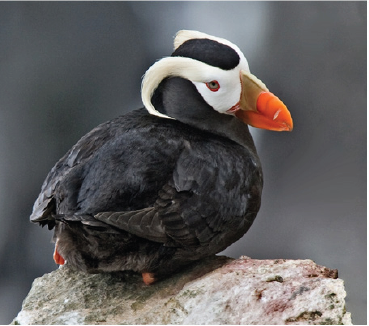
Two good examples supportive of the demand-relationship theory of taste origin are the Macaw and the King Vulture. They have beauty preferences quite different from ours. Though the plumage of Macaws is beautiful to us, the clay-like patterns on their faces look ugly (Figure 626,27). Why? To dispense with the poison contained in the leaves that they eat, Macaws also eat clay. This demand for clay makes them find clay beautiful and the appearance of clay-like spots (in both color and pattern) on their face got selected.
Figure 6: Macaws with cheeks that mimic clay.
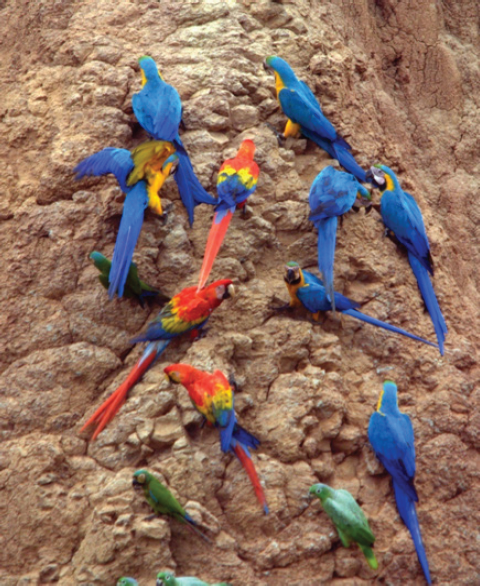
Figure 7: A male king vulture displays the pattern with torn fur and uncovered flesh on neck and gut on nose.
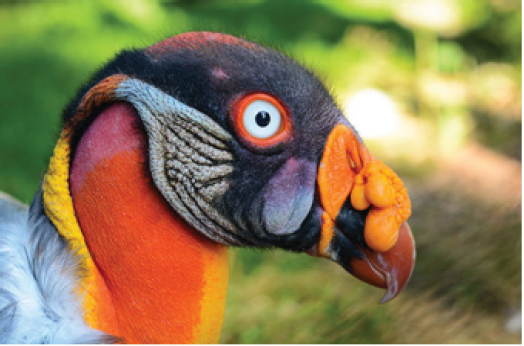
Similarly, as the King Vulture likes to feed on dead bodies of large animals, male King Vultures displays torn fur and uncovered flesh. The Red Headed Vulture28 which also feed on dead bodies displays these features not only on its face but also on its body (Figure 729). The food-source theory may be expanded to include the sustaining- environment theory. Here, an environment X sustains the life of species A well. This relationship allows the evolution of A to have a beauty preference for X as this allows members of A to find X better. Some pattern in the body of the male members that emerge from mutation that looks similar to X then got preferentially selected by the preference of female members.
Figure 8: A male green winged teal.
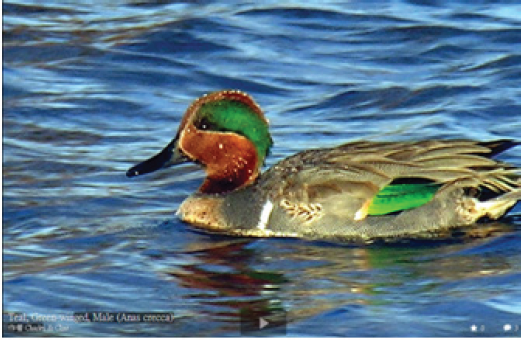
Figure 9: A male baikal teal with the head that displays alluvions on a river.
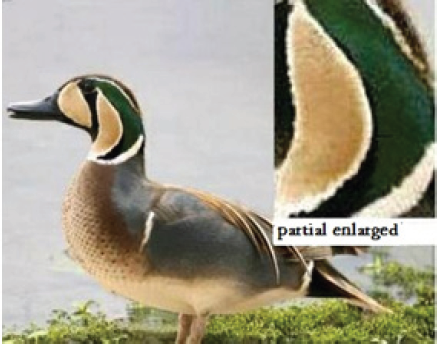
Many species of ducks have, on their plumage, blue or green pattern mimicking deep water, wavy pattern mimicking shallow water, and brown pattern mimicking wetland. For example, the Green Winged Teal have each of these patterns (Figure 830). The Baikal Teal has more delicate island-like pattern (Figure 931). In the winter, Baikal Teals fly to the Yangtze river basin. Sand islands or alluvions in the river are their most favored spots for feeding and resting (being away from predators). The mimicking of alluvions on their faces is very impressive. Note there are green color for river, yellow color for alluvions, black color for river bank, and white color for spoondrift.
Similarly, the Egyptian Plover, which breeds on sandbars or allucions in very large rivers, also displays river and alluvion32. As islands provide safe havens with foods for birds, those birds finding island-like patterns beautiful prefer to choose islands to land on their flights and survive better. Thus, many birds (e.g. Red-breasted Goose33, Spectacled Eider34, Bufflehead35) have island-like patterns. The island-like patterns in arctic birds are usually white, which exactly mimic snow.
There are some birds (eg. most grouses and some birds of paradise) whose appearances may be difficult to explain in terms of their food sources or living environments. There are at least two reasons for this. First, we may not know their habits enough. Before we know that Macaws eat clay, it would be difficult to explain the ugly clay-like pattern and color on their faces. Secondly, the preferred food sources of some species may have disappeared some time ago.
Information and Confidence Level Analyses
From shannon's information theory to semantic information theory
We need to measure the semantic information and the confidence level of a hypothesis. For this purpose, we simply introduce how Shannon's information theory is generalized into semantic information theory. Shannon's [17] mutual information is defined with

Where X is a random variable representing the source, and x1, x2, ..... are its possible values; Y a random variable representing the destination, and y1, y2, .... are its possible values. If Y=yj, then we have the Kullback & Leibler [18] information:

Extending Shannon's information theory, we can obtain the semantic information theory [19-21]. We use θ to denote a predictive model (or model parameters), use θj to denote a sub model associated with yj, and use T(θj|X) to denote the truth function of a hypothesis yj. Using T(θj|X) and P(X), we can obtain a likelihood function [19]:

which is compatible with Popper’s [21, 22] theory well. To average I(X; θj) for different yj, we have the semantic mutual information

I(X; θj) reaches its upper limit: Kullback & Leibler [18] information I(X; yj). If for each yj, P(X|θj)=P(X|θj), then the semantic mutual information I(X; θ) reaches its upper limit: Shannon's mutual information I(X; Y). Dividing the two sides of Eq. (6) by P(X), we have the optimized truth function
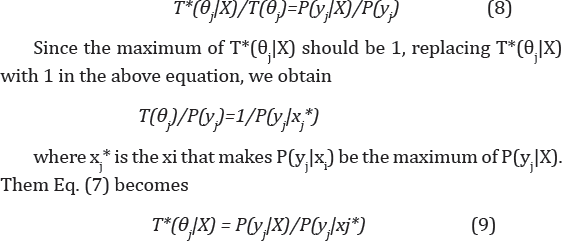
P(yj|X), j=1, 2, ... form a Shannon channel and T(θj|X), j=1, 2,.....form a semantic channel. The above formula shows that when the semantic channel matches the Shannon channel, the semantic mutual information is equal to the Shannon mutual information.
The confidence level of statistical inference from yellow to nectar
We can use information criterion, which was initiated by Popper [22], to evaluate a prediction, such as "Tufted Puffins can catch and like to eat spot prawns". The prior probability in which a bird can catch spot prawns that live under water more 60meters is very small, say 1/500. If tufted puffins really can, the information conveyed by the prediction should be log2500 bits according to Eq. (3). We can use this method to estimate the amount of information of various predictions about birds’ food resources and ideal environments according to birds' appearances. We can also use statistical data to obtain the average semantic information and confidence level of a prediction about birds according Section 3.1.
Figure 10: A Sun Bird with yellow feather is eating nectar.

We found that birds with wavy pattern were most likely to like to drink water frequently (such as several kinds of sandgrouses36) or like to live in or besides shallow water (such as many kinds of ducks); Birds with yellow feather were most likely to like eating nectar (including pollen) [23]. Now we use semantic information method to calculate the confidence level of inference "If a bird has yellow feather then it probably likes eating nectar” to support the demand-relationship theory. Camouflage may be considered a reason; however, most flowers have red petals with yellow stamens (or pistils). So, camouflage is a not a good explanation for yellow feather (Figure 1037).
We use x1 to denote a bird with yellow feather and x0 to denote that without yellow feather, and use y1 to denote "X eats nectar” (X takes value x0 or x1) and use y0 to denote "X does not eat nectar”. The truth function of inference "If a bird has yellow feather then it probably likes eating nectar” is T(θ1|X) where θ1 is a predictive model (sub model of θ) associated with yr The θ1 can also be regarded as a fuzzy set [21] whose elements are birds that like eating nectar. There are 843 representative birds in the book [24]. The book shows the color picture and habit including food preference of each bird. We roughly classified them into four kinds as in Table 1. For some birds, we also made use of supplementary information from some websites. The conditional probabilities and Kullback & Leibler [18] information according Eq. (2) are shown in Table 2. To average I(X;yj) for different yj, we can obtain Shannon’s mutual information I(X;Y)=0.226 bit (according to Eq. (1)). For a universal hypothesis, its four truth values are T(θ1|x1)=T(θ0|xo)=1, T(θ1|xo)=b1' (no-confidence level of yj, and T(θ0|x1)=b0' (noconfidence level of y0). The optimized no-confidence levels
Table 1: The numbers of 4 kinds of birds related to yellow and nectar.
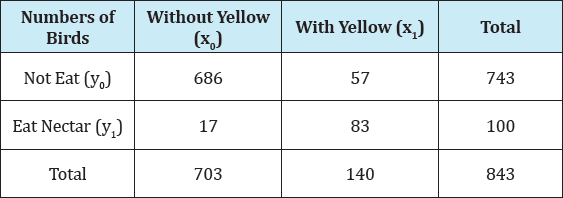
Table 2: Shannon's channel P(Y|X) and Kullback & Leibler [18] information between yellow and nectar.


and semantic Kullback & Leibler [18] information I(X; θ1) and I(X; θO) are shown in Table 3. The b1'* is also the significance level of y1
*θ is a random variable for a predictive model.
The semantic mutual information I(X; θ) is also 0.226 bit. That means, with the optimized confidence levels, we can maximize the semantic mutual information up to its upper limit: Shannon's mutual information. The confidence level of y1 should be b1*=1-b1'*=1-0.04=0.96.
Table 3: Semantic channel T(θ|X)* and semantic Kullback & Leibler [18] information about birds.

Table 4: Semantic information and no-confidence levels of inferences between triglyceride and fatty liver.

The optimized confidence level b1* is equal to 1-1/LR+ [19] (LR+ is the Maximum Likelihood Ratio in medical tests [25]). The maximum semantic information criterion is equivalent to the maximum likelihood criterion and the maximum likelihood ratio criterion [21]. In medical tests, LR+ indicates how good a testpositive is. Obviously, b1* has similar significance; yet, it is more understandable. To understand the information and confidence level of the above inference better, we compare the above inference with inference "If a person has high triglyceride then he probably also has fatty liver". The statistical data [25] from health examines of 500 people show the relationship between triglyceride and fatty liver. Similarly, we can calculate two optimized no-confidence levels and two amounts of semantic Kullback & Leibler [18] information as shown in Table 4.
Comparing b1'* in Table 3 and b1'* in Table 4, we can find that inference "If a bird has yellow feather then it probably likes eating nectar" has higher confidence level and conveys more information than inference "If a person has high triglyceride then he probably also has fatty liver". The hypothesis that demand-relationships select beauty preferences, as an uncertain hypothesis, is supported to considerable extent by the above statistical analyses.
Discussions and Conclusions
We may ask more ultimate questions. Obviously, the colorful flowers are to attract insects to help them cross-pollinate and the beautiful plumage of male birds is to attract female birds. In neither of these cases are they meant to attract humans. A more ultimate question is thus: Why do we humans also find most of these flowers and plumage beautiful? (An exception that proves the rule is the ugly faces of vultures that feed on dead bodies, as discussed above.) We may venture to extend our demand-relationship theory further. Birds and humans have some common food sources like ripe fruits. This makes both birds and humans find ripe fruits beautiful. By extension, this makes us find the plumage of most birds beautiful. Many flowers are beautiful to humans because they bear edible fruits. Humans also find many flowers not bearing edible fruits beautiful because they are similar to other flowers and show fertile environments. More discussions about human beauty preferences can be found in [11]. We wish the above explanations can attract more researchers who may yield more insights.
We have provided ultimate explanations for the origin of particular beauty preferences. In particular, the origin of certain patterns/colors in birds in terms of their food demand and living environment is explained with some convincing photos. Our demand-relationship theory may be subject to rigorous test. We have examined many predictions, according to bird's appearances, such as the Baikal Teal and the Egyptian plover's liking alluvions in rivers, the Sunbittern's liking eating butterflies, the King Eider's liking eating snails, the Macaw's liking eating clay (There are more photos38). We also use statistical data to calculate the confidence level of hypothesis "If a bird has yellow feather then it probably likes eating nectar", which is high up to 0.96 and strongly support our demand-relationship theory. We still need to further examine some predictions, such as the Tufted Puffin's liking eating prawns, the Mandarin Duck's liking eating clams. We also find some birds, such as the Sage Grouse, with peculiar appearances that are hard to be explained by the demand-relationship theory. Partly because of expertise limitations and partly for the sake of ecological changes, we can only leave these to other researchers.
Acknowledgement
The author thanks Professor Yew-Kwang Ng (who is a famous economist at Nanyang Technological University. His studies on welfare economics with happiness criterion are very attractive and helpful to the author) for his encouragement and help in writing this paper.
Footnotes
1 Thanks to author, from http://lxs.cncn.com/53654/n357640
2Thanks to author, This image is licence free from https://ccsearch.creativecommons.org/image/detail/uA0Qy6etODx6WWp99i5jFQ
3 Thanks to author, This is a royalty free image from https://www.dreamstime.com/royalty-free-stock-photos-blueberry-bush-image11589318
4 Thanks to author, More details about peacocks, see http://blog.sciencenet.cn/blog-2056-872375.html
5Thanks to author, This image has licence granted from http://coolhqpix.blogspot.ca/2011/02/worlds-most-beautiful-birds-photos.html
6Thanks to author, from http://blog.sciencenet.cn/home.php?mod=space&uid=2056&do=album&picid=422991
7Thanks to author, from http://blog.sciencenet.cn/home.php?mod=space&uid=2056&do=album&picid=427860#pic_block
8Thanks to author, from http://blog.sciencenet.cn/home.php?mod=space&uid=2056&do=album&picid=440247
9Thanks to author, from http://blog.sciencenet.cn/home.php?mod=space&uid=2056&do=album&picid=428603#pic_block
10 Thanks to author, From licence free website http://www.nipic.com/show/2930954.html. Thank the author.
11 Thanks to author, From http://www.sxagri.ac.cn/166/kfbpubzljs.asp?id=504. Thank the website and the author for kind permission.
12 Thanks to author, from http://ibc.lynxeds.com/photo/sunbittern-eurypyga-helias/one-bird-perching-rock-middle-cristalino-river
13 Thanks to author, from http://blog.sciencenet.cn/home.php?mod=space&uid=2056&do=album&picid=410908
14 Thanks to author, from http://blog.sciencenet.cn/home.php?mod=space&uid=2056&do=album&picid=8516
15 Thanks to author, from https://en.wikipedia.org/wiki/Brown_thrasher
16 Thanks to author, from http://blog.sciencenet.cn/home.php?mod=space&uid=2056&do=album&picid=422990
17 Thanks to author, from http://blog.sciencenet.cn/home.php?mod=space&uid=2056&do=album&picid=601203
18 Thanks to author, from http://blog.sciencenet.cn/home.php?mod=space&uid=2056&do=album&picid=601208
19 Thanks to author, from http://blog.sciencenet.cn/home.php?mod=space&uid=2056&do=album&picid=326538
20 Thanks to author, from http://blog.sciencenet.cn/home.php?mod=space&uid=2056&do=album&picid=8515
21 Thanks to author, from http://blog.sciencenet.cn/home.php?mod=space&uid=2056&do=album&picid=8513
22 Thanks to author, from http://blog.sciencenet.cn/home.php?mod=space&uid=2056&do=blog&id=742139
23 Thanks to author, from http://stock.chrisdoddsphoto.com/famain.asp?customerId=112&sKey=GHCSEHNJ&action=viewimage&cid=76'lid=0&imageid=283
24 Thanks to author, from http://img3.imgtn.bdimg.com/it/u=1808009408,2066031166&fm=214&gp=0.jpg
25 Thanks to author, This image with freen licence is from https://en.wikipedia.org/wiki/Tufted_puffin
26 Thanks to author, from http://blog.sciencenet.cn/home.php?mod=space&uid=2056&do=album&picid=410907
27 Thanks to author, By Brian Ralphs - originally posted to Flickr as DSC_8774.NEF, CC BY 2.0, https://commons.wikimedia.org/w/index.php?curid=9678869.
28 Thanks to author, from http://www.indianaturewatch.net/displayimage.php?id=354041
29Thanks to author, This image with CC licence is from https://en.wikipedia.org/wiki/King_vulture.
30Thanks to author, This image with CC licence is from http://www.flickr.com/
31Thanks to author, from http://www.cnbird.org.cn/ (search "Baikal Teal” can find the creator Lool and his works)
32Thanks to author, from http://en.wikipedia.org/wiki/Egyptian_Plover
33Thanks to author, from http://tolweb.org/Branta_ruficollis/89154
34Thanks to author, from https://en.wikipedia.org/wiki/Spectacled eider
35Thanks to author, from https://en.wikipedia.org/wiki/Bufflehead
36 Thanks to author, from https://en.wikipedia.org/wiki/Sandgrouse
37 Thanks to author, This image with licence granted is from https://ccsearch.creativecommons.org/image/detail/1xRWOpDNb4In4apQG-HMiA==
38Thanks to author, from http://blog.sciencenet.cn/home.php?mod=space&uid=2056&do=album&id=23161
References
- Darwin C (1959) On the origin of species by means of natural selection, John Murray, New York, USA.
- Darwin C (1871) The descent of man, and selection in relation to sex, John Murray, New York, USA.
- Wallace AR (1871) Review of darwin’s descent of man. The Academy 2(20): 177-183.
- Wallace AR (1897) Notes on natural selection. Natural Science 1: 749740.
- Cronin H (1991) The ant and the peacock, Cambridge University Press, London, UK.
- Fisher RA (1915) The evolution of sexual preference. Eugenics Review 7(3): 184-192.
- Grammer K, Fink B, Moller AP, Thornhill R (2003) Darwinian aesthetics: sexual selection and the biology of beauty. Biological Reviews 78(3): 385-407.
- Lodé T (2007) Sexual propaganda as a new theory of sexual selection. Evolutionary Ecology and Ethology, Universite Rennes, France, Europe.
- Lu C (1987) Trying to resolve the problem left by darwin about fragrance, sweetness and beauty. Information from Nature (in Chinese) 25-27.
- Lu C (1989) On beauty as feedback signal of stirring loving mood (in chinese). Journal of Changsha University 3: 56-60.
- Lu C (2003) The mystery of beauty taste and the evolution of needs (in chinese). China Science and Technology University Press, Hefei, China.
- Jacobs ME (1998) Mr. Darwin misread miss peacock’s mind: A new look at mate selection in light of lessons from nature. Nature Books, Victoria, Australia.
- Rodd FH, Hughes KA, Grether G, Baril CT (2002) A possible non-sexual origin of a mate preference: Are male guppies mimicking fruit? Proc R Soc B 269(1490): 475-481.
- Morell V (2002) Guppy sex and gluttony guided by orange glow. Science 295(5561): 1816-1817.
- Yang XJ, Wen JX, Yang L (1997) The Range of green peafowl in southwest and northwest yunnan province, china. Zoological Research (in Chinese) 18(2): 12-18.
- Yang ZS, He JW, Tang XK, Li Y, He ZJ, et al (2008) Resources of wild vaccinium l in the northwest of yunnan province. Southwest China Journal of Agricultural Science (in Chinese) 21(4):1059-1064.
- Shannon CE (1948) A mathematical theory of communication. Bell System Technical Journal 27(3): 379-429 and 623-656.
- Kullback S, Leibler R (1951) On information and sufficiency. Annals of Mathematical Statistics, 22(1): 79-86.
- Lu C (1993) A generalized information theory (in Chinese). China Science and Technology University Press, Hefei, China.
- Lu C (1999) A generalization of Shannon's information theory. Int J of General Systems 28(6): 453-490.
- Lu C (2016) Semantic information measure with two types of probability for falsification and confirmation.
- Popper K (1963) Conjectures and refutations, Repr (2005) Routledge, London and New York, UK pp.1-45.
- Harrison C, Greensmith A (1993) Eyewitness handbooks-birds of the world, Dorling Kidersley Limited, London, UK.
- Thornbury JR, Fryback DG, Edwards W (1975) Likelihood ratios as a measure of the diagnostic usefulness of excretory urogram information. Radiology 114(3): 561-565.
- Yin G, Ding J, Gong Q, Shi L, Liu J (2006) The relationship of fatty liver with high blood lipids, high blood glucose and high UA. Modern Medicine Journal of China, 8(9): 7-8.
© 2018 Chenguang Lu. This is an open access article distributed under the terms of the Creative Commons Attribution License , which permits unrestricted use, distribution, and build upon your work non-commercially.
 a Creative Commons Attribution 4.0 International License. Based on a work at www.crimsonpublishers.com.
Best viewed in
a Creative Commons Attribution 4.0 International License. Based on a work at www.crimsonpublishers.com.
Best viewed in 







.jpg)





























 Editorial Board Registrations
Editorial Board Registrations Submit your Article
Submit your Article Refer a Friend
Refer a Friend Advertise With Us
Advertise With Us
.jpg)






.jpg)













.bmp)
.jpg)
.png)
.jpg)














.png)

.png)



.png)






